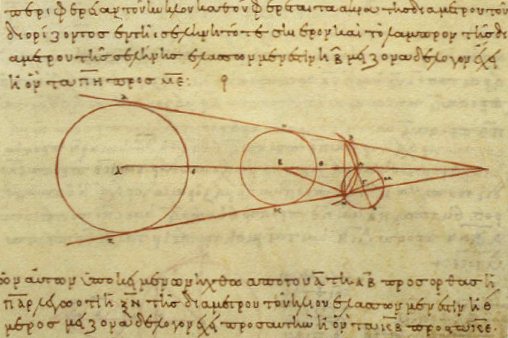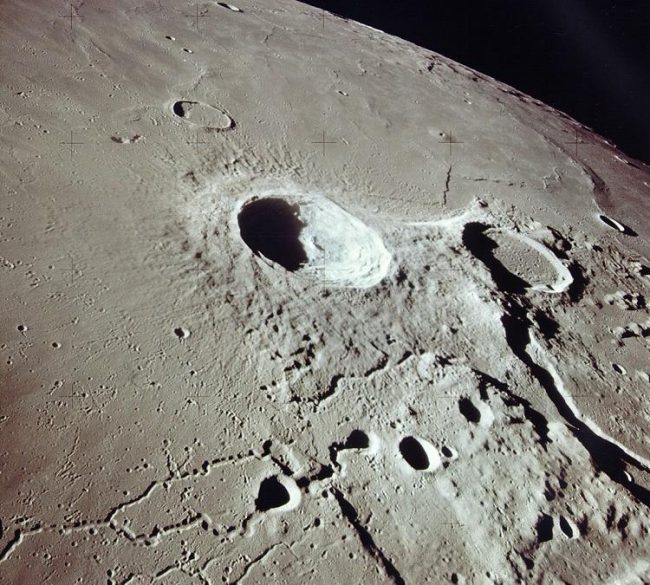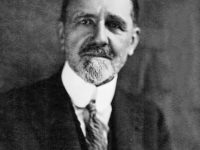
Aristarchus’s 3rd-century BC calculations on the relative sizes of the Sun, Earth and Moon
About 310 BC, ancient Greek astronomer and mathematician Aristarchus of Samos was born. He presented the first known model that placed the Sun at the center of the known universe with the Earth revolving around it. As Anaxagoras before him, he also suspected that the stars were just other bodies like the Sun. His astronomical ideas were often rejected in favor of the geocentric theories of Aristotle and Ptolemy.
“The earth is to the moon in a ratio greater than that which 1259712 has to 79507, but less than that which 216000 has to 6859.”
– Aristarchus, On the Sizes and Distances of the Sun and the Moon (c. 250 BC)
A Student of Strato
Apparently, Aristarchus of Samos was a student of the peripatetic philosopher Strato of Lampsacus, who was head of Aristotle’s Lyceum. It is not clear however, that Aristarchus studied with Strato in Athens but rather that he studied with him in Alexandria. Aristarchus is mostly mentioned by Vitruvius, who was famous as a Roman architect and engineer, and the author of the important treatise ‘De architectura‘. In this work Vitruvius lists men who have been knowledgeable across all branches of science:
Men of this type are rare, men such as were, in past times, Aristarchus of Samos, Philolaus and Archytas of Tarentum, Apollonius of Perga, Eratosthenes of Cyrene, Archimedes and Scopinas of Syracuse, who left to posterity many mechanical and gnomonic appliances which they invented and explained on mathematical principles.
Geocentric vs Heliocentric Model
Vitruvius also explains that Aristarchus invented a “sundial in the shape of a hemispherical bowl with a pointer to cast shadows placed in the middle of the bowl“. However, there are no clear evidences concerning the origin of Aristarchus’s belief in a heliocentric system. The Greeks had not accepted the hypothesis and therefore, it never gained enough popularity. Apparently, historians only found out about Aristarchus’s believes through Archimedes. As Archimedes reported Aristarchus’ views, he also criticized them as “mathematically meaningless proportions“.[1] During the 4th century BC, Plato and Aristotle defended the geocentric model but both philosophers did so using mostly mystical and mythical arguments. The stars and planets were carried around the Earth on spheres, arranged in a concentric fashion. Plato even described the “universe as the Spindle of Necessity, attended by the Sirens and turned by the three Fates“. Plato explained that natural laws could not account for all the changes in the universe. Plutarch also wrote about Aristarchus, saying that he probably followed Heraclides of Pontus’ believes that the daily rotation of the fixed stars was a result of the rotation of the Earth on its axis. [2]
Publications are Lost
It is suggested that there is only one surviving work of Aristarchus: “On the Sizes and Distances of the Sun and Moon“. However, the publication is not based on the Sun centered theory. Also, the work in which Aristarchus probably described his theory on a heliocentric system is lost. “On the Sizes and Distances of the Sun and Moon” states that the Sun was about 20 times as distant from the Earth as the Moon, and 20 times the Moon’s size. These estimates were too small, which was probably the result of inaccurate instruments. It is believed that his work was published before Aristarchus adapted the believe of a heliocentric system. [1,2,3]

This is a view of the Aristarchus and Herodotus craters taken from orbit during the Apollo 15 mission. The view is toward the south. Aristarchus crater is near the center of the image, and the flooded Herodotus is to the right.
Problems with Heliocentrism
It is not clear if Aristarchus sticked with his believe of the heliocentric system after most astronomers had rejected the theory. Hipparchus of Nicea was one of the most respected Greek astronomers, who concluded that the geocentric model better explained the observations than did the model of Aristarchus. It was found that the only way that Aristarchus’ theory could stand mathematical analysis was by supposing an elliptical orbit of the Earth, an assumption that was not accepted in the community.[2]
Lunar Eclipses
Aristarchus also watched the moon moving through the Earth’s shadow during a lunar eclipse. He concluded that the diameter of the Aarth was 2.85 times that of the moon. In fact, this factor is about 3.67. Furthermore, Aristarchus recognized that the half moon is created by the fact that the sunlight falls exactly perpendicular to our direction of view of the moon. The triangle sun, moon, earth thus shows a right angle at half moon.
The Heliocentric Revolution
Only about 1800 years later was the heliocentric worldview of Nicolaus Copernicus [5] taken up again and comprehensively elaborated. With explicit reference to Aristarchus, Copernicus propagated the heliocentric world view in his work De revolutionibus orbium caelestium (1543).
Ian Morison, Voyages to the Outer Solar System, [6]
References and Further Reading:
- [1] John J. O’Connor, Edmund F. Robertson: Aristarchos von Samos. In: MacTutor History of Mathematics archive
- [2] Aristarchus at the Ancient History Encyclopedia
- [3] Aristarchus at Cornell University
- [4] Aristarchus of Samos at Wikidata
- [5] Nikolaus Copernicus and the Heliocentric Model, SciHi Blog, February 19, 2013.
- [6] Ian Morison, Voyages to the Outer Solar System, Gresham College @ youtube
- [7] Timeline of Ancient Greek Astronomers, via DBpedia and Wikidata






Pingback: Whewell's Ghost